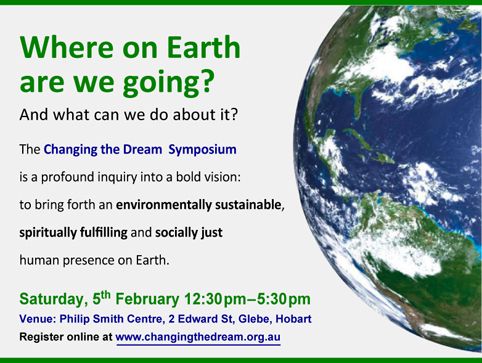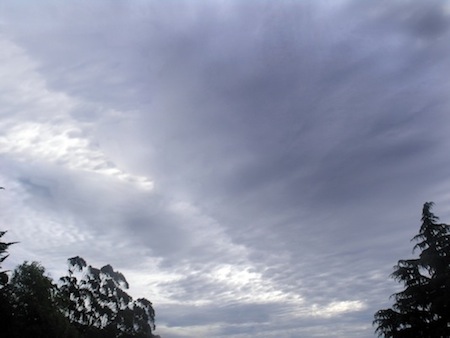Dealing with a counter-intuitive reality [11 January 2011 | Peter Boyer]
Walking the dog on Fern Tree’s Pipeline Track, every so often I encounter our local weatherman, Bradley Hudson. We chat about this and that, including of course the weather — and there’s always plenty of that on Mount Wellington.
Bradley isn’t a professional weatherman, but he records daily rainfall captured by his back-yard gauge. He’s got an inquiring mind, and enjoys (as I do) looking for patterns in the weather.
We’ve been mulling over the strange shift in the pattern of rainfall in 2010, when Bradley’s records show two radically different regimes in Fern Tree. After a damp 2009 we suddenly reverted to the dry pattern of earlier years, seven months of dry topped off by a pathetic 14 mm of rain in July.
Then the heavens opened. August alone (including a record 160mm on one day) nearly doubled the annual total, and things stayed that way for the rest of the year. We had enough rain in five months to raise our total close to the long-term yearly average.
This same divide — dry until August, then wet — was the rainfall story across Southern Tasmania last year. Bureau of Meteorology climatologist Melanie Webb reported that several southern sites, including Hobart, had their driest January-to-July on record, although parts of the north (notably Launceston, which had a highest-ever 850.7 mm of rain) had above-average yearly totals.
Nationally, rainfall has been dominated by another dichotomy: a very dry year for the south-west including Perth, and a wet one for most of the rest of Australia. Last year saw an emphatic end to 14 years of drought in the Murray-Darling basin and brought record flood levels to Queensland, which had its wettest year on record.
Too much water can be as devastating as too little. How can you be thankful for the rain when it’s just ruined your harvest-ready wheat crop, or inundated your mango orchard? The farmers’ misery will soon be ours; some fruit and vegetable prices are set to quadruple over coming months.
Another quirk of 2010 rainfall: the Northern Territory’s dry season, normally around seven months long, lasted just one month last year. With a dry-season average across the North of 190 mm, it was the wettest dry season on record. If this keeps up we’ll have to find a new name for it.
By contrast, over 40 years of steady drying in Australia’s south-western corner reached record levels. Western Australia is building desalination plants to replenish an alarmingly depleted natural supply, but the schemes’ capital and energy costs make Perth water the nation’s most expensive.
 But for most Australians, with cloudy days dominating the latter half of the year (and some notable snowstorms burying our own Mount Wellington), the sense as we departed 2010 was that it wasn’t such a warm year.
But for most Australians, with cloudy days dominating the latter half of the year (and some notable snowstorms burying our own Mount Wellington), the sense as we departed 2010 was that it wasn’t such a warm year.
This is where the public discourse about global warming seems to go off-track. When the sky’s not blue and there’s rain or snow about, a warming planet is the last thing on people’s minds.
In the weeks leading up to Christmas, northern Europe and the eastern seaboard of the United States got a big dump of snow — the second year in a row for many places. The sight of buried homes and immobilised motor vehicles prompted politicians in the US to declare global warming dead.
That’s the gut reaction, but it’s wrong. For one thing, when the latter part of your year has been wet (as ours has) it’s hard to remember that most of the year was dry, just as it’s hard for snow-bound Americans or Europeans to think back to a very warm summer. A Muscovite is probably not thinking of his city’s astonishing mid-year forest fires while clearing December ice from his pipes.
For another, a quick check of a global map would be all the doubters should need to realise that the west of Europe and the US east coast do not make a world, any more than Australia or Tasmania do. They’re a tiny fraction of the planet’s surface area, 70 per cent of which is open ocean.
The hard data on the global picture are still being fine-tuned, but we can be sure that last year, for all the frozen roads and airports, will be among the three warmest ever — and may yet top them all.
Australia’s 2010, the Bureau of Meteorology reports, was its 31st warmest year since national records began in 1910 — not at all auspicious from a temperature perspective. I’m sure this will attract some to conclude, with the US politicians, that global warming is dead, but it pays to look at this from a bit of a distance.
Though last year doesn’t rank particularly high, it was still warmer than the standard 1961-1990 average — the ninth year in a row that this has happened — and the decade that it ends (2001-2010) was the warmest decade in the 101 years since Australia-wide records began.
While the La Nina big wet of 2010 kept temperatures down in Australia’s interior, the continent’s north and west were much warmer than usual, with Cape York Peninsula’s record warming affected by above-average sea surface temperatures in the Coral Sea.
Maximum temperatures were below average, but night-time temperatures (always a good indicator of greenhouse warming) were comfortably above average, including an Australian record July overnight minimum of 26.9C at a Northern Territory station.
Tasmania, too, had a warmer than average year, with Hobart having a record long run of mild days, its second-highest mean temperature on record, and a record high mean maximum. The story rolls on.

